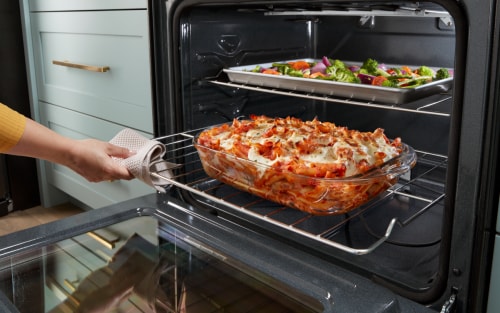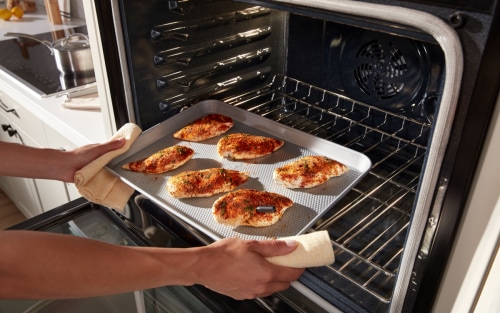
How to baste a turkey like a professional
Basting a turkey can bring out the savory flavors of your favorite herbs or oils while helping to keep your bird moist and ready for your family to enjoy. Basting your turkey using seasoned marinades helps create a crisp exterior to your meat while also creating a tender bite. Read on to learn how to baste a turkey and what to baste a turkey with. Once you try it, you’ll love the taste and texture it brings to your turkey.
What is basting?
Basting is a method to add flavor and moisture to meat or poultry using hot oils, sauces or juices as it cooks. These hot liquids are applied with basters, brushes or spoons, among other tools. This technique can give your turkey a deep golden color, indicating a crisp texture and a juicy bite.
Basting a turkey like a professional
Basting like a pro is about choosing the right method for your family, creating a tasty herb oil and basting your bird once every hour. Keep in mind that every time you open your oven you lose heat, so it’s a good idea to remove the turkey and close the door during every basting session. There are a number of tools that offer different application techniques for basting your bird. Choose one ahead of time to help keep basting times quick and efficient.
Ingredients
Turkey
Kosher salt
Ground black pepper
Olive oil, optional
Butter, optional
Tools
Roasting rack set
Turkey baster, optional
Basting brush, optional
Ladle, optional

Turkey basting method #1: Turkey baster method
A turkey baster is shaped like an oversized bulb syringe and is great for extracting, applying and redistributing hot liquids from tight spots, like pan juices under the turkey. Squeeze the bulb and slowly let it go to draw in liquid. Gently squeeze the bulb again to redistribute the juices, applying the baster at an angle, if needed, for precision.

Turkey basting method #2: Spooning method
Spoons and ladles are often great options for scooping from deep pans and generously applying liquids. If your dish is deep, carefully tilt it slightly to pool the liquid in a corner, then scoop upward with your spoon or ladle, and redistribute the juices over your turkey. A long-handled ladle works well for precise scooping and pouring, especially in deep roasting pans.

Turkey basting method #3: Basting brush
Silicone or pastry brushes are great for gently and evenly applying liquids. Flexible brushes are handy for a precise, light application to specific areas, such as wings or turkey breasts. Dip the brush into your sauce or marinade, then apply it to your turkey. Consider using a silicone brush for oil or drippings distribution.


When to baste a turkey
It is recommended to baste a turkey approximately every hour as it cooks in your oven. Refrain from basting more often than that, as opening and closing your oven too frequently results in a loss of heat.
Is it better to baste a turkey with butter or oil?
Deciding whether to baste with butter or oil primarily depends on your own preferences. However, butter is the preferred choice in many recipes due to its flavor. If you choose an oil, consider a high-heat compatible oil such as vegetable or canola oil.
Always practice caution when handling oils and butters for basting. Spillage and stains from grease and oil can be tough to remove from aprons or clothing.


Turkey basting recipe tips
- Consider the oven rack placement in order for the turkey to cook evenly and give you quick access to baste.
- Experiment with herbs and other options in your pantry. Some basting recipes call for chicken broth while others prefer a butter and herb mixture.
- Have a plan. Minimize the number of times you open the oven to baste. Each time you open it, the oven loses heat, which can lead to longer cook times. Have your basting oils and tools ready when itʼs time to baste.
- You can make a gravy with extra liquid you have leftover in your pan.
Allow for your turkey to cool after cooking. Juices often redistribute when you allow your meat to rest. Carving too soon can cause the juice to end up on your carving board and could lead to dry meat.
Discover Whirlpool® Ovens
Whirlpool® Wall Ovens can help you create delicious family feasts. Explore advanced features on select models like Fan Convection Cooking, ideal for creating a golden brown finish on your turkey, and Air Fry Mode for perfectly crispy wings and fries. With a range of sizes, including 24, 27 and 30-inch oven options, there’s an oven to suit your kitchen and family needs. Amp up your home cooking experience with Whirlpool® Wall Ovens.
Explore oven settings with Whirlpool brand
-
 13 Oven Settings & Symbols Explained Learn what different oven settings mean and how to use them. Get familiar with various oven functions, including Broil, Bake, Convection, Roast and more.
13 Oven Settings & Symbols Explained Learn what different oven settings mean and how to use them. Get familiar with various oven functions, including Broil, Bake, Convection, Roast and more. -
 Understanding How Ovens Work to Cook Food Discover how gas, electric and convection ovens work to heat and cook your food. Find out the key mechanics of an oven with this guide.
Understanding How Ovens Work to Cook Food Discover how gas, electric and convection ovens work to heat and cook your food. Find out the key mechanics of an oven with this guide. -
 How Long Does it Take to Preheat an Oven? Learn why you need to preheat an oven and how long an oven takes to preheat completely. Gas ovens and electric ovens may take different times to preheat.
How Long Does it Take to Preheat an Oven? Learn why you need to preheat an oven and how long an oven takes to preheat completely. Gas ovens and electric ovens may take different times to preheat.


home heartbeat
Ready for more tips, home hacks and appliance guides?





